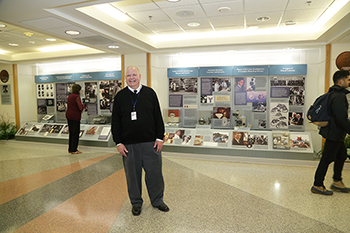NIH in History: Two Exhibits
History Exhibits at NIH
A New Set of Drawings by Santiago Ramón y Cajal

Newly arrived is the latest set of seven neuroanatomy drawings by Santiago Ramón y Cajal on rotation on the first floor of the Porter Neuroscience Center (Building 35). The drawings date back to the turn of the last century when Santiago Ramón y Cajal shared the Nobel Prize (1906) with Camillo Golgi for their work on the structure of the nervous system. We thank our partners at the Cajal Institute in Madrid, Spain for making this exhibit possible. You can see the original drawings, or touch 3-D prints of enlarged drawing details for the next year.
Celebrating the Lives of Michael Potter and Nobel Laureate Christian Anfinsen

PHOTO BY: BILL BRANSON, OD
Hank Grasso (pictured), an exhibition content developer in the Office of NIH History and Stetten Museum, led the design of the Potter and Anfinsen exhibits on display in the Clinical Center (Building 10).
The twin exhibits—titled “Curiosity and Collaboration: The Work of Michael Potter” and “Christian Boehmer Anfinsen: Protein Folding and the Nobel Prize”—are positioned in the long, first-floor corridor of Building 10, just “north” of the FAES bookstore.
Potter, who died in 2013, was an ingenious and generous researcher whose 50-year career at the National Cancer Institute was distinguished by amazing discoveries and superb mentoring. Potter’s research focused primarily on plasma cells, a form of white blood cells that produce antibodies. His 1984 Albert Lasker Award for Basic Medical Research was for his “elegant studies of plasma cell tumors, leading to the development of monoclonal antibodies and enlarging our knowledge of carcinogenesis and the immune system.”
Like Potter, Anfinsen had a long and productive career at the NIH, first at what was then called the National Heart Institute and later as chief of the Laboratory of Chemical Biology in what is now the National Institute of Diabetes and Digestive and Kidney Diseases (NIDDK). Anfinsen’s book, The Molecular Basis of Evolution, published in 1959, demonstrated the scientific and disciplinary affinities between molecular genetics and protein chemistry. Anfinsen shared half of the 1972 Nobel Prize in chemistry for “work on ribonuclease, especially concerning the connection between the amino acid sequence and the biologically active conformation.”
The Potter and Anfinsen exhibits were built by the Office of NIH History and Stetten Museum with funding from NIDDK, NHLBI, and NCI. Find out about other historical exhibits, and where they are located at https://history.nih.gov/museum/onsite.html.
This page was last updated on Wednesday, April 6, 2022
